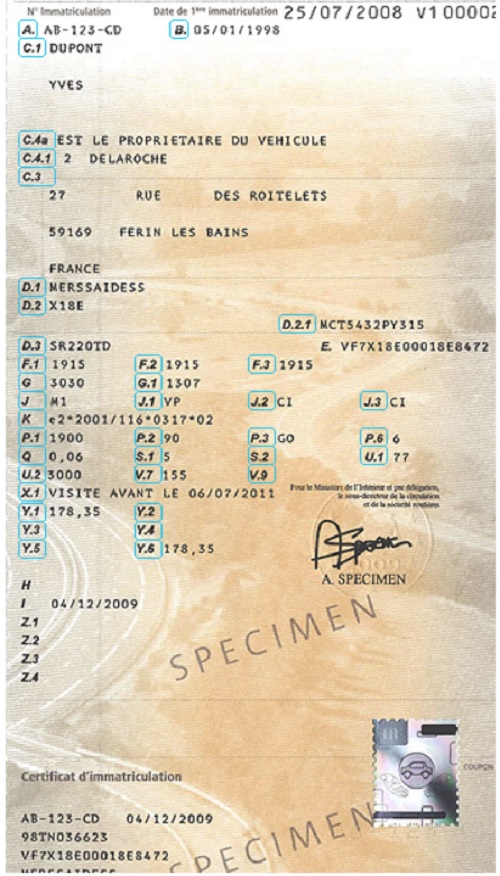The Carte Grise Explained
Friday 10 January 2020
The 'carte grise' is the official vehicle registration document in France.
Purpose
The carte grise (CG) is officially called the 'certificate d’immatriculation', although both terms are in common use.
The document has several purposes, notably to confirm:
• that the vehicle, at the time of registration, was checked for compliance with French and EU laws governing the use of vehicles on the public highway;• that it has been officially registered with the appropriate authorities and that a licence number has been allocated via a registration process called 'immatriculation';
It does not certify that the vehicle is roadworthy and legally compliant at a given time, for which purpose you need a 'control technique'.
Neither is the CG an incontestable proof of vehicle ownership, even though it gives the vehicle’s owner and their address. Other bodies, notably finance providers, may have a legal claim on the vehicle.
Together with your driving licence and certificate of insurance, it forms part of the mandatory set of documents you must carry with you when you are driving a vehicle in France.
The CG may be requested by the police during the random stops and compliance checks that are quite commonplace in France, although whether or not an offence will be enforced in the event of a transgression will depend on the circumstances and the judgment of the individual gendarme or police officer.
Contents
An image of a specimen CG is shown below.

The document describes the vehicle under different headings including:
• its registration number (A);• the date it was first registered (B);
Acquiring a Carte Grise
In most cases, when you purchase or otherwise acquire a vehicle in France it will come with its CG. That applies whether you are purchasing from an individual or a professional dealer.
Only where it is a new vehicle or imported would there be any reason for the vehicle not to have a CG. A vintage car may also be without a CG, although this would be rare.
As a purchaser, you clearly need to check the CG corresponds to the vehicle. In collaboration with the seller you can use the government website Histovec to check the history, as well as undertaking a visual check of the vehicle identification number etc.
It is not entirely unknown for there to be the odd genuine error on a registration document. If you find such an error getting the details changed on the document can involve a considerable amount of time and cost.
On the sale of a vehicle, a detachable coupon on the CG is signed by the vendor and given to the buyer as part of proof of purchase. The coupon permits the new owner to drive the vehicle for a month while they apply for a revised CG with their name and address on it.
As part of the sale process the seller will invalidate the main part of the document by writing across it the date and time of the sale. Both buyer and seller should sign it. Sellers should not complete this process until they have received irrevocable payment for the vehicle and it would be prudent to retain a copy of the signed document.
A new owner will need to provide a copy of the document as part of their application for a new CG. You must keep the original document on your files for 5 years after your purchase.
There may be other circumstances where you will need to apply for a new CG. They include:
• you discover, usually following your receipt of an automatic traffic fine, that your car's registration number has been cloned and is being used illegally by another vehicle, an increasingly common problem. In such circumstances, you can usually disclaim responsibility for the offence (with supporting evidence/rationale). You are required to apply for a new registration number and associated CG;
• you may be modifying your vehicle (e.g. replacing the engine) so that the details on the registration document would no longer be accurate;
• you acquire a vehicle only to subsequently discover that the details on the CG do not match the vehicle itself. This may or may not indicate that the vehicle is stolen or that the registration document is fake;
• you change address, or on marriage, death, or divorce to have it in your correct name, joint or single name;
• in the event of being lost, stolen or defaced. If lost or stolen, you are required to immediately inform the police/gendarmes.
Application Process
The process of applying for a new CG is now exclusively on-line, a task that is not easy to accomplish due to technical problems and the design characteristics of the registration site.
Taxes are payable on a new registration, which can be considerable, although they are only nominal for a mere change of name or change of address.
You can read about the application process and the taxes in our guides below.
Thank you for showing an interest in our News section.
Our News section is no longer being published although our catalogue of articles remains in place.
If you found our News useful, please have a look at France Insider, our subscription based News service with in-depth analysis, or our authoritative Guides to France.
If you require advice and assistance with the purchase of French property and moving to France, then take a look at the France Insider Property Clinic.





